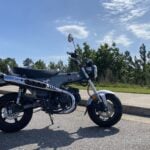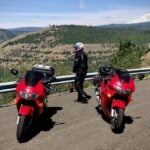Differences and Preferences
As we’ve noted before, the off-road, “dual-purpose” motorcycle segment has been exploding as of late. Even in these pandemic times, maybe because of them, more and more people have been wanting, needing, to visit the great outdoors for some mind and soul refreshment. And what better means than by motorcycles?
So many of us grew up riding dirt bikes in our youth, and many of us are “playing in the dirt again” aboard modern dual sport and adventure motorcycles. We’ve been riding and reviewing an example of each ourselves lately, a 2022 Honda CRF300L and a 2022 Yamaha Tenere 700, regaining our “dirt legs” as best we can.
Perfect examples of dual sport and adventure motorcycles- a Honda CRF300L, and a Yamaha Tenere 700.
A reader emailed us recently with the question, “What do you see as the major differences between dual sport bikes and adventure bikes?” We thought that to be a worthy inquiry, so we will share our observations here. The Motorcycle Industry Council (MIC.org) lumps both together in a category they call “dual-purpose” in regards to overall motorcycle sales, but are they really quite different motorbike types? Both are road-ready and dirt-worthy, so why not classify them together?
We see some clear distinctives between dual sport motorcycles and adventure motorcycles, yet with a some notable “line-blurring” exceptions as well. Let’s start with a short history lesson.
When some of us “Baby Boomers” were youngsters, a motorcycle type called “enduro” was fairly popular. An enduro was essentially a dirt bike kitted out for street-legal riding. These had a headlight, mirrors, turn signals fore and aft, brake lights, and a license plate mount. A road-going motocross bike, essentially. Phil owned a Honda Elsinore as a teen, a fine example of the “enduro” class in its time. Today the term is mostly reserved for longer-distance off-road racing bikes, and the term “dual sport” has come to define this “dual-purpose” subsegment.
“King of Cool” Steve McQueen astride his trusty Honda Elsinore CR250. Photo by McQueen Online.
In the early 1980s, BMW pioneered what would come to be called “adventure bikes” with their revolutionary R80G/S. This was a larger displacement, heavier motorcycle based on their venerable street machines, but with taller suspension, higher fenders, semi-knobby tires, and tubed/spoked rims. An all-day road bike with serious dirt chops. Other brands scratched their heads at it, then jumped on the new bandwagon with bikes like the Honda Africa Twin, Kawasaki KLR650, and the Cagiva Elefant, among others.
And a new motorcycle segment was born- the adventure bike.
The bike that launched a new motorcycle segment- the BMW R80G/S.
Okay, so what’s the difference(s) between dual sport and “ADV” bikes today? Here’s a few of our observations:
Purpose and Design
Simply stated, in our estimation a dual sport motorcycle is basically a dirt bike for the street, whereas an adventure bike is basically a road bike for the dirt. The overall design and styling cues of each usually lend themselves to identifying the bike type. Dual sports bear an uncanny resemblance to motocross machines, while adventure bikes tend to look, well, like a marriage between a sport tourer and a large, long-legged dual sport.
Displacement and Capacity
Dual sport motorcycles traditionally are smaller displacement (often 500cc or less) singles or twins, while adventures tend to be larger (650cc on up) twins, triples or 4-bangers. Dual sports also tend to have shorter range due to small fuel tank capacity, whereas ADV bikes usually have large tanks, 4+ gallons and larger, for longer rides in the saddle. Both have long-travel suspensions, but in our experiences so far, the larger adventure machines have tended to be a bit taller than their dual sport counterparts. There are exceptions to these of course- the Suzuki DR650S is considered a large dual sport, while the Royal Enfield Himalayan is a smaller adventure bike running a 411cc single thumper mill. Someone is always bucking convention.
A Triumph Tiger 900 Rally, and a Royal Enfield Himalayan. Both fantastic motorcycles on road or in dirt.
Accessories and Price Tag
Adventure motorcycles can be kitted out for world travel, literally, with entire brand catalogs of OEM farkles and aftermarket goodies to fully accessorize them for all kinds of environments. An entire industry has risen to create and produce elements for adventure touring- clothing, gear, luggage, bike parts, you name it. Dual sport bikes can be outfitted with many add-ons as well, but the segment hasn’t gone nuts with offerings like the ADV market has. The dual sporters we know tend to keep their bikes fairly stripped of creature comforts, preferring to hit the dirt (or street) with more minimalist rigs. You’ll tend to spend under $10K for a rock-solid dual sport, but (most) adventure bikes tend to have much higher price tags than that.
Rider Types
Another observation we’ve noted is this- owners of adventure motorcycles, while kitting out their bikes like they’re riding across Asia and dressing to match, mostly ride on the street, and roll only occasional dirt/gravel. And that’s exactly what makes ADV bikes such a fantastic choice for so many. Heck, that’s our attraction to adventure bikes. Dual sport riders tend to be very dirt-oriented in our view, spending weekends riding trails, single and dual track, hard pack, etc. astride their bikes, using pavement only as necessary.
Deep in the woods with a dual sport and an adventure.
What’s Right For You?
That’s a question only you can answer. But here’s a few cues as to what might suit you best:
*Do you really enjoy off-roading, more than street riding? The dual sports would be your best bet.
*What’s your height? Adventure bikes might be uncomfortably tall and top heavy if you are 5’8” or under (like Rob or Joshua), yet fit you perfectly if you are taller, say, 5’9-10” on up (like Ted or Phil).
*Are you mostly a road rider, enjoy road trips? There are so many great adventure bikes to choose from today.
So that’s our take on the dual sport and adventure bike craze. Whatever you ride, wherever you roll, whether pavement or earth, we hope you enjoy the ride, and #RideLife.
Road Dirt Crew
*Rider gear: Bell Qualifier helmets, BILT Spirit 2 gloves, Sedici Marco Mesh jacket.
Check out our “Dual Sport and Adventure Bike” video below, without ever leaving this page:






























Come on now, the Honda Elsinore was a motocross bike not and Enduro bike and didn’t work to well for Enduro riding in New England , they were ok for open trail riding or motocross but didn’t work to well in deep mud or rocky riverbeds, or steep technical sections where Enduro bike smoother power delivery and torque was needed, although I had a friend who could ride his Suzuki rm370 anywhere I could go on my Enduro bike but he was and exceptionally good rider
Actually, Honda offered the MR250 Elsinore, a dual sport, in 1975. https://www.motorcycleclassics.com/classic-japanese-motorcycles/1975-MT250-Elsinore-zmwz15jazhur/
True, but a CR250 is not an MR250. Totally different bike.
When I was 15, I bought a new Honda MT125 Elsinore and can recall it being called an enduro. Nowadays, it is referred to as a dual sport, but do a search for dual sport at the cycle trader website and the result is terrible. Could be a few reasons for this.
The definition of any bike category is always interpreted different. Sport touring is a category that is often blurred.
Good article here about the dual sport and adventure bike differences.
i have both tools for riding. My kids started me on dirt bikes. i then acquired a dual sport, Honda CRF 250l, for riding backroads, trails and camping. The occasional highway and open country stretches were brutally loud and uncomfortable on the dual sport so I also acquired an ADV bike for longer trips on dirt with highway segments. You are right about height. though. I am only 5’7″ and not a life long rider. A tall and/or heavy ADV is not for me. My solution has been the Honda CB 500X, with twin cylinders and sufficient horsepower and comfort for highway, but easier to handle on dirt and crude roads. Also, great mileage and range.